Science
Desperate parents turn to magnetic therapy to help kids with autism. They have little evidence to go on
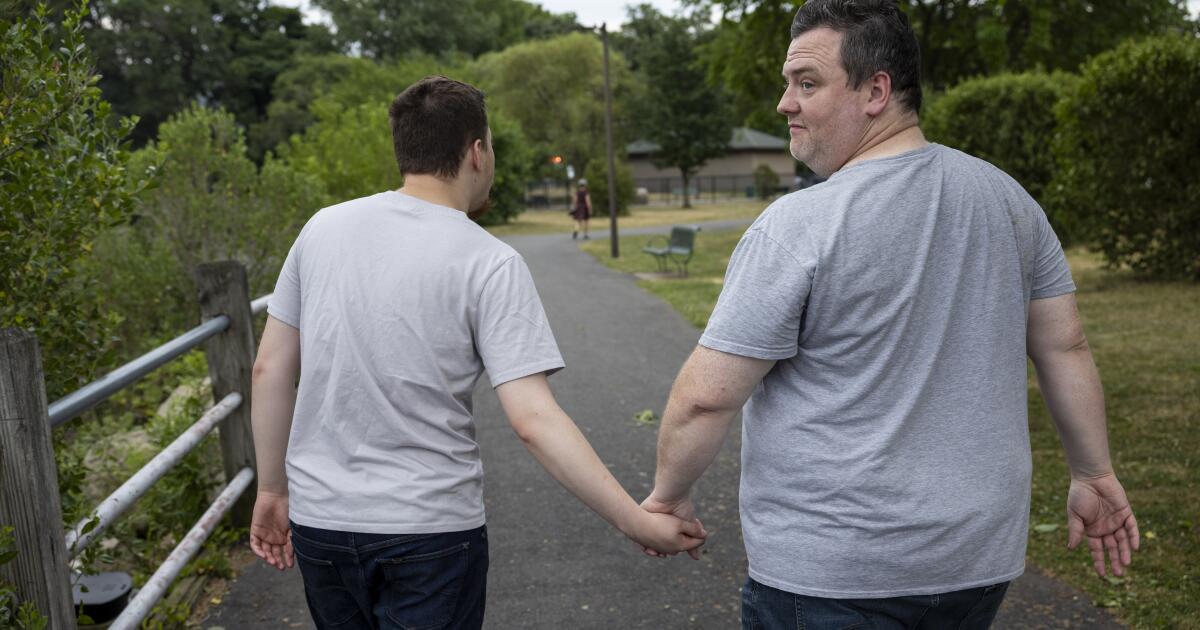
Thomas VanCott compares his son Jake’s experience with autism to life on a tightrope. Upset the delicate balance and Jake, 18, plunges into frustration, slapping himself and twisting his neck in seemingly painful ways.
Like many families with children on the autism spectrum, Jake’s parents sought treatments beyond traditional speech and behavioral therapies.
One that seemed promising was magnetic e-resonance therapy, or MERT, a magnetic brain stimulation therapy trademarked in 2016 by a Newport Beach-based company called Wave Neuroscience.
The company licensed MERT to private clinics across the country that offered it as a therapy for conditions including depression, PTSD and autism.
Those clinics described MERT as a noninvasive innovation that could improve an autistic child’s sleep, social skills and — most attractive to the VanCott family — speech. Jake is minimally verbal.
It was expensive — $9,000 — and not covered by insurance. “It’s too much for most things,” VanCott said, “but not for the potential of my child speaking.”
“It just did nothing,” Thomas VanCott says of the $9,000 MERT sessions his son received.
(Claudia Paul / For The Times)
After raising money through GoFundMe, VanCott met with a doctor at a New Jersey clinic who described how MERT would reorganize Jake’s brain waves. VanCott does not have a scientific background, and the technical details went over his head. What he had was a severely disabled son he was desperate to help.
The doctor “seemed pretty confident. And his confidence gave me confidence,” VanCott said. “It made me think, tomorrow Jake’s gonna wake up and say a sentence.”
Autism diagnoses in children have risen steadily since 2000, in part due to increased awareness and screening. As the number of people living with autism has grown, so have alternative therapies promising to alleviate or even reverse its associated behaviors.
“There’s also a lot of pressure put on parents,” said Zoe Gross, a director at the Autistic Self Advocacy Network, a nonprofit group run by and for autistic adults. “People will be saying things like, ‘Time’s ticking, your kid’s missing milestones … you have to fix it now.’”
One therapy that often surfaces in Google searches, social media groups and word-of-mouth discussions is MERT, which is based on a brain stimulation therapy approved by the Food and Drug Administration for depression and obsessive-compulsive disorder.
Clinics offering MERT sell it as a “safe and effective treatment for autism” that yields “miraculous results” for kids on the spectrum.
Most compelling to many families is an oft-cited marketing claim that research has shown MERT to improve speech and eye contact in a majority of autistic patients, research that several clinics attributed to Wave.
The Times spoke to parents who said MERT caused positive, lasting changes in their autistic children’s sleep, communication and concentration.
Other parents told The Times they saw only minimal changes in their children’s behavior. Many, including Thomas VanCott, saw no changes at all. “It just did nothing,” VanCott said. And a few saw worrying behavioral regressions that persisted long after the therapy ended.
All remember being told by MERT providers that while results weren’t guaranteed, many patients saw positive results. When the dramatic changes they hoped for didn’t happen, these families left believing they were unlucky. Without quality data, it’s impossible to know if any of these outcomes are outliers or typical patient experiences.
Wave has not conducted any studies on whether its signature product works for autism. A Wave executive argued that the need for new autism therapies is strong enough to justify moving forward with commercial solutions before rock-solid evidence is available.
“Academics pointing towards insufficient evidence for clinical adoption may not represent a true reflection of clinical utility in a population where there are very few therapeutic options, great suffering, and a willingness of physicians and patients to seek innovative treatment choices with diligent clinical care and oversight,” said Dr. Erik Won, Wave’s chief medical officer.
For many parents, even a small possibility of a life-changing breakthrough is worth any price. Although some families have reported benefits from the treatment, no large scientific studies exist that show MERT is significantly better than a placebo, according to nine psychiatrists, psychologists and neuroscientists with expertise in brain stimulation and autism.
MERT is Wave’s trademarked version of a therapy called transcranial magnetic stimulation. The product of decades of research, TMS is approved by the FDA to treat major depression, OCD and cigarette addiction.
It is also used to treat conditions for which it is not FDA-approved, in what’s known as “off-label” prescribing. Off-label use of drugs and devices is a common practice in medicine.
Clinics offering cash-pay TMS for a variety of off-label conditions, including autism, have proliferated in recent years. MERT in particular has become especially popular among families with autistic children.
Autism spectrum disorder is a complex neurological and developmental condition that manifests differently in nearly every individual who has it. Symptoms cluster around difficulties in communication, social interaction and sensory processing.
Many autistic people need minimal support to live, work and thrive independently, while others require intense daily care and are unable to express themselves verbally. There are few evidence-based interventions to alleviate the disorder’s most profoundly disabling traits.
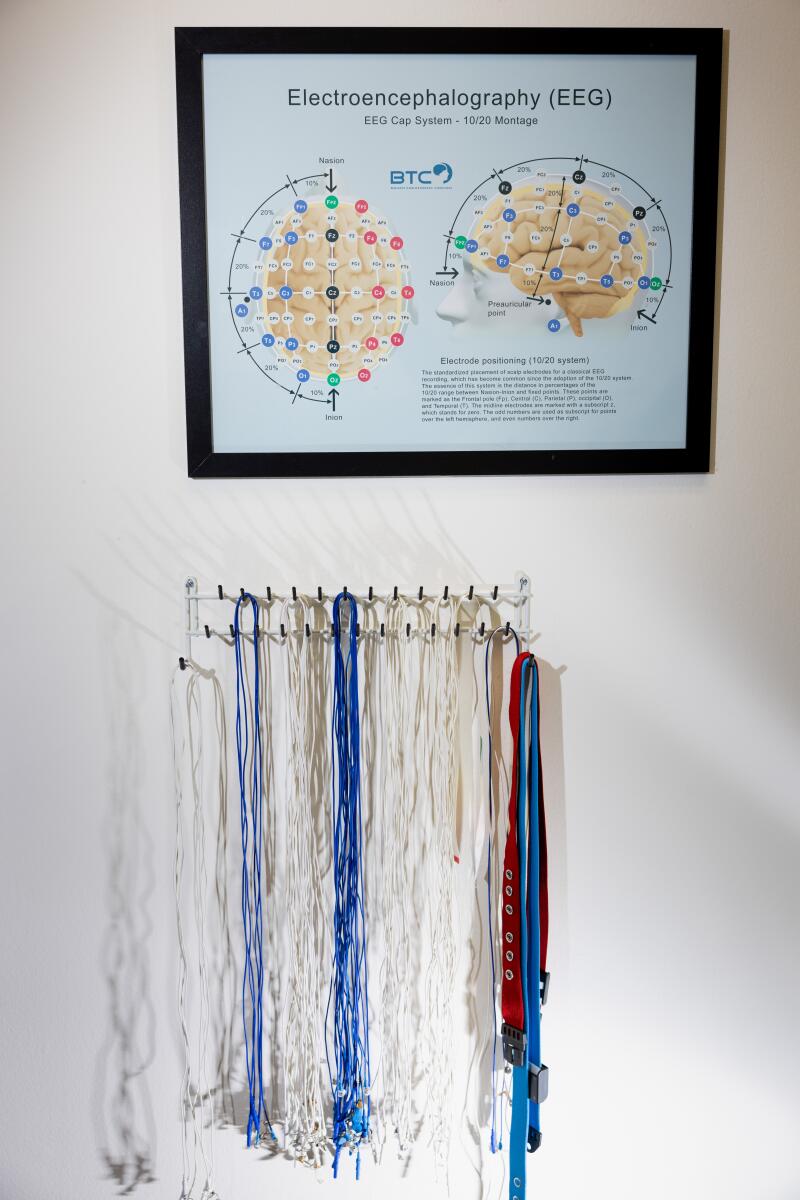
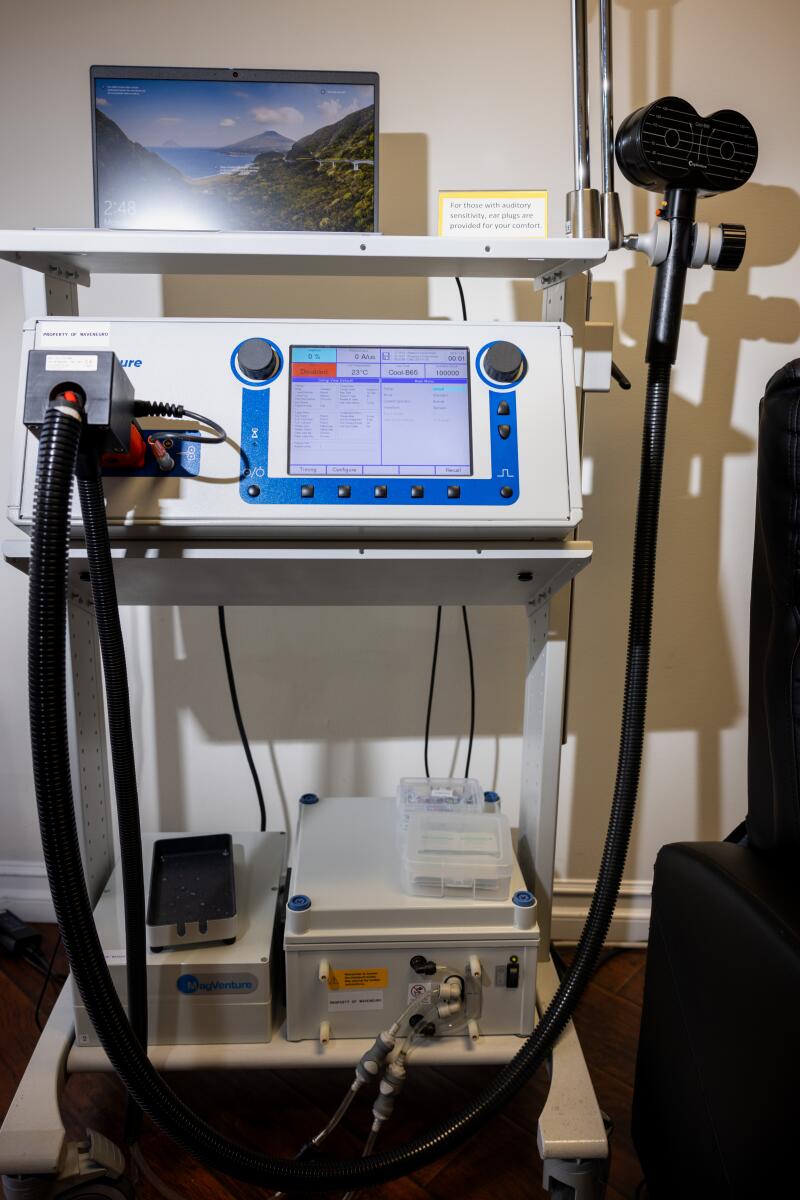
MERT providers first use EEG, a common brain scan, to assess patients. Wave’s proprietary technology, photographed at a Newport Beach clinic, then determines which areas of the brain to target for treatment. (Jay L. Clendenin / Los Angeles Times)
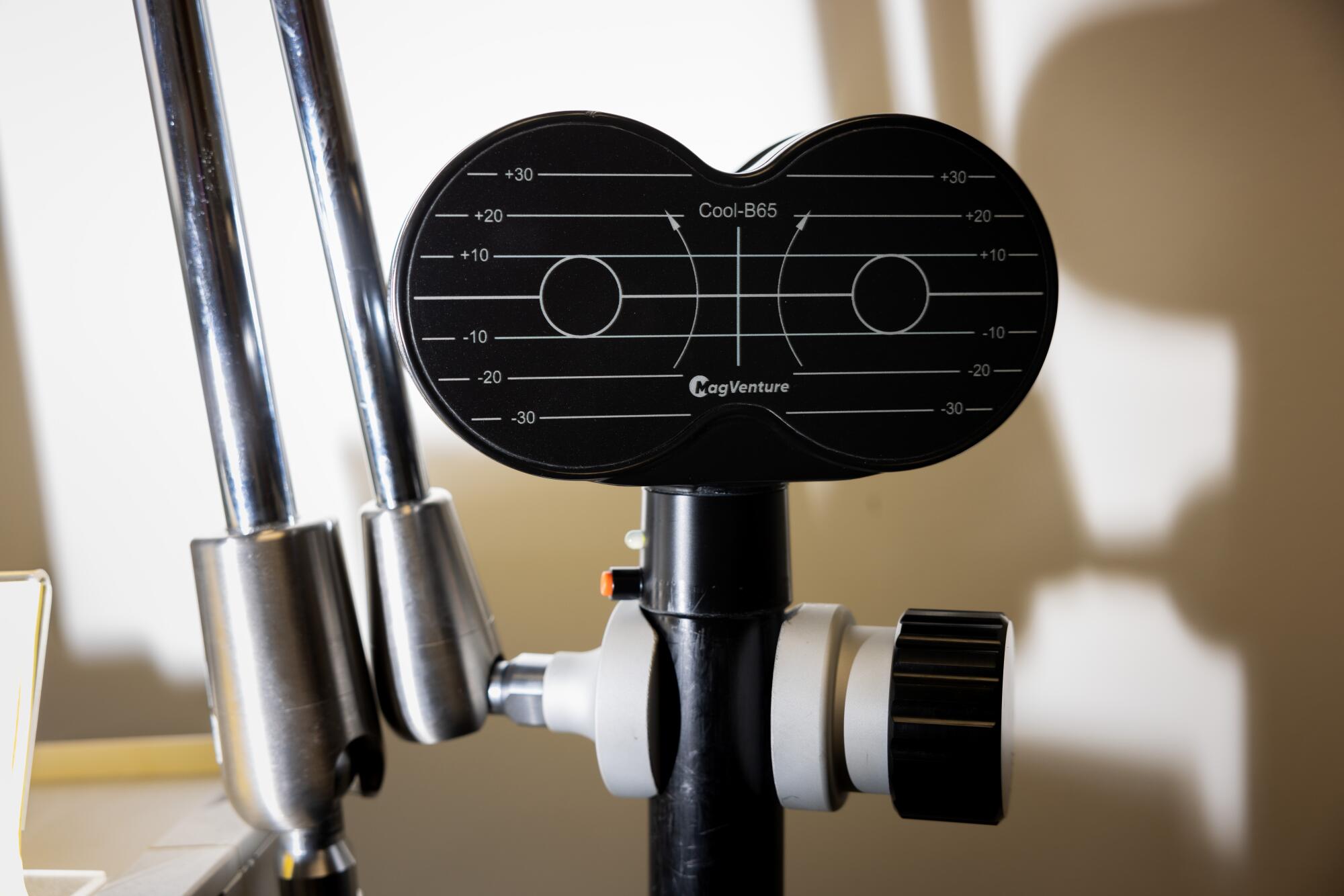
During treatment, a magnetic coil is placed against the patient’s scalp. Each session of gentle electromagnetic pulses lasts about 30 minutes.
(Jay L. Clendenin / Los Angeles Times)
A MERT patient first sits for a 10-minute quantitative electroencephalogram, a noninvasive test that measures the brain’s electrical activity, and an electrocardiogram, which gauges electrical activity in the heart.
Results are then analyzed by Wave’s proprietary software. If its algorithm identifies “areas of the brain that are not functioning properly,” clinic providers will recommend a protocol of TMS-style treatments. In these sessions, the provider places a magnetic coil against the patient’s scalp that emits a gentle electromagnetic pulse. Sessions typically last about 30 minutes and are administered five days a week, for two to six weeks.
Won, Wave’s president and chief medical officer, said the goal is “to help the brain function most efficiently as an organ. And the hypothesis was, if we improve the metabolic efficiency of the brain, would we see some changes in a variety of different medical conditions?
“As we sort of tested this, there was a realization: Wow, we can do something pretty special for autism,” he said.
A six-week course of MERT — the standard protocol Wave recommends for autistic patients — typically costs $9,000 to $12,000, families and clinic owners said, and is not covered by insurance.
MERT was originally developed as a therapy for post-traumatic stress disorder and traumatic brain injury. Since Wave’s inception in 2019, it has described military veterans as its primary patient demographic.
Wave is in Phase II of a clinical trial to test MERT for PTSD, Won said. The company has not conducted any clinical trials on autism.
“The strategic decision to focus on PTSD was largely dictated by market factors,” Won said. He added that his company is dedicated to helping those with autism and is working to obtain funding “for further studies and ultimately an FDA indication.”
Dr. Andrew Leuchter is the director of UCLA’s TMS Clinical and Research Service, which has provided FDA-approved and off-label treatments to more than 1,000 patients.
Given its solid safety profile and effectiveness at treating other complex brain-based disorders, Leuchter said that he and many other TMS clinicians believe the therapy could have benefits for conditions other than the few for which it is FDA-approved.
When a patient approaches the clinic seeking treatment for an off-label condition Leuchter believes could be helped by TMS, the psychiatrist reviews the case with his colleagues. If they decide to proceed, he explains to the patient that the efficacy of TMS for their condition isn’t proven, though there is reason to believe it is safe and effective.
But when parents call asking whether he can treat autistic characteristics such as sensory challenges, minimal speech or lack of eye contact, Leuchter says no.
“Off-label treatment can be just fine so long as there’s data to support this and the risks are low,” he said. For autism, he said, “the evidence base is not very strong. … And I don’t think that there is sufficient evidence to recommend the use of TMS for the treatment specifically of autism.”
Multiple researchers are currently examining whether TMS could improve certain symptoms of autism. But eight researchers interviewed for this article said there isn’t yet enough evidence to recommend TMS as an autism therapy, or to say with confidence that it works for that condition.
Lindsay Oberman, director of the Neurostimulation Research Program at the National Institute of Mental Health, published a paper last year summarizing the current state of research on TMS and autistic children. Nearly all published studies on the treatment to date have been very small, open-label (meaning both patients and providers knew which treatment they were receiving) or focused on a very specific subgroup, she and her co-authors wrote.
Without large, randomized controlled trials — the gold standard in medicine — “broad off-label use of these techniques in this population is not supported by currently available evidence,” the paper concluded.
Won acknowledged that the company has so far not pursued such research on MERT and autism.
“We owe the community some academically rigorous science,” he said. “This is not going to be a panacea. I don’t want to misrepresent anything to the parents who are making these difficult decisions. But for a subgroup, this is clearly something that’s leading to a response.”
Medical research moves far more slowly than most patients and their families would like, and many are willing to try experimental therapies long before researchers and regulators are ready to sign off on them.
“When you’re a parent of a child and you think that this can help, it’s like, FDA be damned, right?” VanCott said. “If I think it’s gonna help my kid, I want to do it.”
Wave’s provider directory now lists more than 60 U.S. licensees and an additional 18 internationally. More than 400,000 MERT sessions have been administered to more than 20,000 people, according to the company.
Won said Wave does not maintain comprehensive data on patients treated at licensee clinics. In an interview, he estimated that about half of these patients were seeking treatment for autism. He later said that 20% to 30% was a better estimate.
Although some clinic owners said they treat few autistic children, staffers at multiple facilities told The Times that most or all of their patients were autistic.
To pay for the procedure, families have used savings or turned to crowdfunding. Others placed the treatment on credit cards. Their experiences vary widely.
Though initially skeptical, Joo Flood booked a six-week course of treatment at a Dallas clinic in 2022 for her minimally verbal son Max, then almost 5. They returned for another round in May 2023.
Max now responds far more often to his name, makes regular eye contact and has an easier time following directions, his mother said.
“If I didn’t do the MERT, I’m not sure Max can be at this level,” she said.
Yestel Concepcion and her husband sought MERT for her stepson after hearing about it on a talk show.
The New Jersey couple scraped together savings and gratefully accepted donations from friends and family for the $10,000 cost. They spent nearly $5,000 more relocating the family to Maryland during the monthlong treatment.
Apart from an increase in the boy’s hyperactivity, the couple saw “no result whatsoever,” Concepcion said. The clinic suggested more sessions, at an additional cost. But their money and trust had run out.
Most parents who spoke to The Times about their children’s MERT treatments said the possibility of speech for their nonverbal or minimally verbal children was the primary reason they pursued it, even if it meant taking on debt.
Until recently, more than a dozen MERT clinics around the country, under the headline “Results that ‘Speak,’” cited an “internal double-blind randomized control trial” that had produced striking results: Two out of three patients who had difficulties with verbal and nonverbal communications “experienced improvement” after MERT. In the same trial, the ad copy read, 70% of patients who had trouble maintaining eye contact saw “improved eye contact behavior.”
Four clinics attributed those statistics to Wave.
According to Wave, the source of that claim is a small study of 28 patients that was conducted around 2017 by the Newport Brain Research Laboratory. It has not been published nor vetted by independent scientists. The study was among assets of the now-defunct laboratory that Wave purchased in 2019.
The only part of this work available to the public is an undated poster presentation that roughly outlines the study.
Wave declined to release details of the study or name its authors, but Won described the results. He said 71% of subjects in the group of 14 patients that received MERT instead of a placebo had positive changes in their visual response afterward, and 67% of subjects had positive changes in their verbal communication, according to their parents’ responses on the Childhood Autism Rating Scale, known as CARS.
“I never put much weight into the findings I see in a poster or talk, especially if it isn’t followed by a later peer-reviewed publication,” said Christine Conelea, an associate professor at the University of Minnesota Medical School who runs the university’s Non-Invasive Neuromodulation Laboratories.
“Small samples like this aren’t good for establishing the benefits of a treatment, conclusively showing safety or demonstrating that an investigational treatment is better than placebo,” Conelea said.
Statistics taken from the unpublished study have featured prominently on the websites of at least 17 MERT clinics, as well as the primary website for the Brain Treatment Center, a trademark owned by Wave under which many MERT clinics do business.
Won said he was not aware that so many clinics were using the study’s conclusions as a marketing tool. Shortly after The Times asked Wave about the statistics, almost all of those clinics took them down.
“I don’t feel good about it,” he said. “A lot of families benefited from it [MERT], and their children are doing better, and that’s wonderful. But I don’t want to misrepresent or overrepresent things. … I would always want there to be published, peer-reviewed, academically rigorous science to back up a claim.”
Following The Times’ questions, Won said that Wave contacted the study authors and requested that they expedite the preparation and submission of a research paper containing the study results to a peer-reviewed journal. The company has also asked the authors to release the manuscript on a preprint server, a website where scientists can post preliminary findings.
“We need to get that publication out so that people can make informed decisions,” he said. “It would be easier if it’s in the public domain, and other people can critique it and break it down and take it for what it’s worth.”
Manuel Casanova, a retired University of South Carolina professor who spent years studying TMS as a potential autism therapy, questioned why MERT providers had so little empirical data to share after administering the treatment to thousands of autistic patients — a gap, he said, that “raises a red flag as to the therapeutic benefits of the technique.”
MERT providers operate in an “ethical gray area,” said Anna Wexler, an assistant professor at the University of Pennsylvania who studies the ethics of emerging technologies.
Doctors can use approved therapies to treat any condition they deem appropriate, Wexler said. But if the condition being treated isn’t the same one for which the therapy has been cleared, providers must be “as transparent as possible” about the evidence they’re relying on, she said. If there is little or no evidence to support MERT’s efficacy for a given condition, she said, “it is unethical for providers to advertise that it is effective.”
“If someone opts for an experimental therapy, that in itself is not problematic,” Wexler said. “What is problematic is if they are making that decision based on erroneous or incorrect beliefs about efficacy.”
Won did not respond to a question about Wexler’s critique.
Nine psychiatrists, psychologists and neurologists with expertise in transcranial magnetic stimulation say there is to date no evidence to suggest this kind of therapy can reliably prompt a nonverbal autistic child to develop speech, or to significantly alter an autistic child’s sensory and communication abilities.
“The plain English is that it’s not there yet, and I have not seen it working convincingly outside of a strong placebo effect,” said Dr. Alexander Rotenberg, a professor of neurology at Harvard Medical School and director of Boston Children’s Hospital’s Neuromodulation Program.
Peter Enticott, a psychologist at Australia’s Deakin University, is leading a multisite trial of TMS for autism funded by the Australian government. Enticott has spoken with families whose children received MERT from Wave licensees in Australia and were thrilled with the outcomes. But for a scientist, uplifting anecdotes are not a substitute for data.
“It’s too early,” he said. “And I think it’s particularly problematic given that they are charging large amounts of money for an unverified therapy.”
Criticisms of the treatment’s pricing were “not a reflection of Wave Neuroscience,” Won said. “The comments seem to be objecting to the realities of the healthcare market.”
Scientists consulted by The Times said they would encourage families interested in TMS and autism to look for a clinical trial that would provide the treatment free of charge in exchange for using the patient’s data in a study.
“I would consider this something that should be researched, but nobody should be paying $5,000 to $10,000 out of pocket for this,” said Alycia Halladay, chief science officer at the Autism Science Foundation, one of five autism advocacy groups The Times consulted that said there is not enough evidence for them to recommend MERT.
Despite his disappointment, VanCott does not regret his decision. Had he not pursued the treatment, he would always have wondered whether he had turned down something that could have helped his son — no matter how high the cost, no matter how slim the chance.
“I mean, being able to sleep at night?” he said. “What’s that worth?”
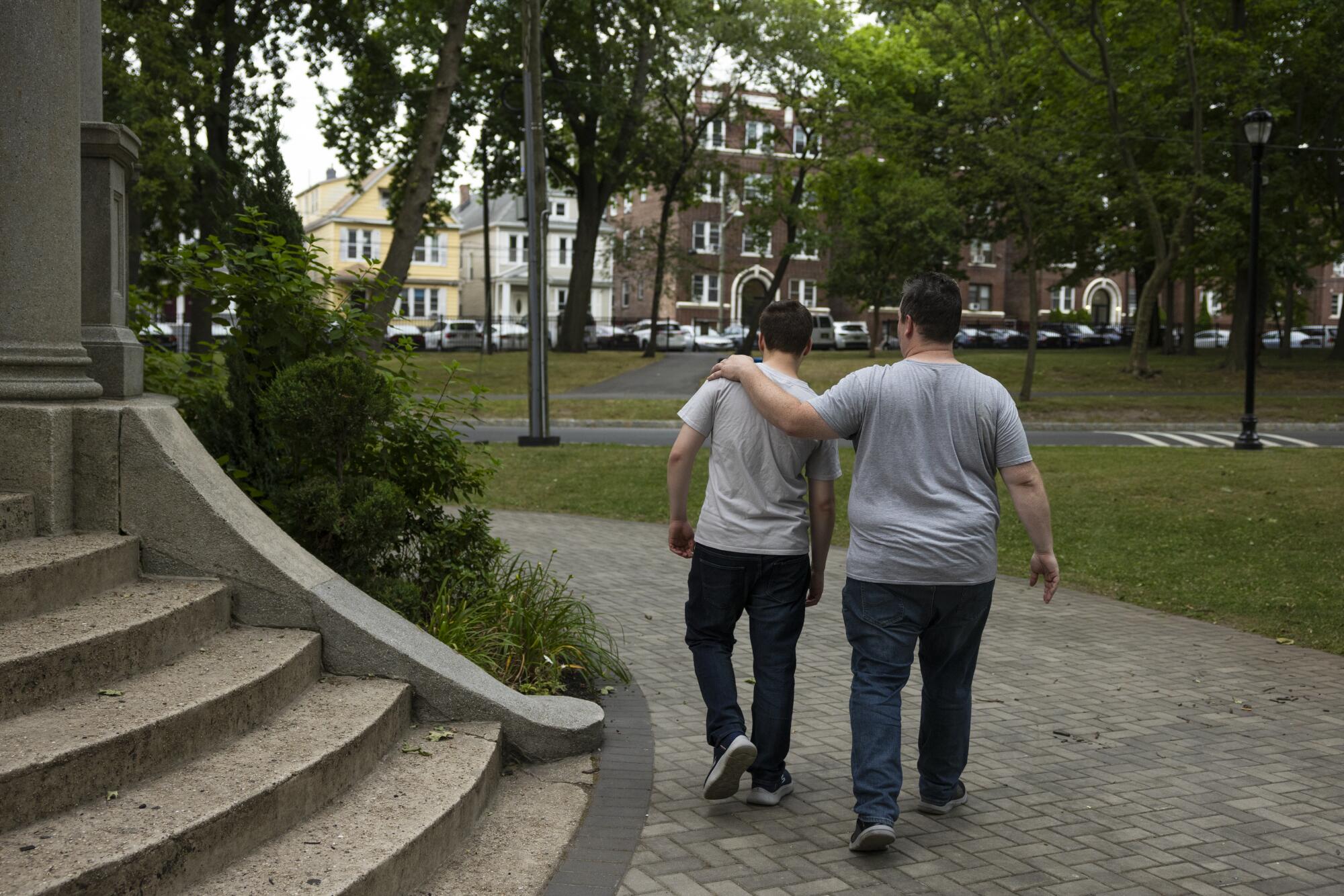
Thomas VanCott said he signed up son Jake for MERT sessions because he did not want to be wondering whether he turned down something that could have helped his child.
(Claudia Paul / For The Times)

Science
California’s last nuclear plant clears major hurdle to power on

California environmental regulators on Thursday struck a landmark deal with Pacific Gas & Electric to extend the life of the state’s last remaining nuclear power plant in exchange for thousands of acres of new land conservation in San Luis Obispo County.
PG&E’s agreement with the California Coastal Commission is a key hurdle for the Diablo Canyon nuclear plant to remain online until at least 2030. The plant was slated to close this year, largely due to concerns over seismic safety, but state officials pushed to delay it — saying the plant remains essential for the reliable operation of California’s electrical grid. Diablo Canyon provides nearly 9% of the electricity generated in the state, making it the state’s single largest source.
The Coastal Commission voted 9-3 to approve the plan, settling the fate of some 12,000 acres that surround the power plant as a means of compensation for environmental harm caused by its continued operation.
Nuclear power does not emit greenhouse gases. But Diablo Canyon uses an estimated 2.5 billion gallons of ocean water each day to absorb heat in a process known as “once-through cooling,” which kills an estimated two billion or more marine organisms each year.
Some stakeholders in the region celebrated the conservation deal, while others were disappointed by the decision to trade land for marine impacts — including a Native tribe that had hoped the land would be returned to them. Diablo Canyon sits along one of the most rugged and ecologically rich stretches of the California coast.
Under the agreement, PG&E will immediately transfer a 4,500-acre parcel on the north side of the property known as the “North Ranch” into a conservation easement and pursue transfer of its ownership to a public agency such as the California Department of Parks and Recreation, a nonprofit land conservation organization or tribe. A purchase by State Parks would result in a more than 50% expansion of the existing Montaña de Oro State Park.
PG&E will also offer a 2,200-acre parcel on the southern part of the property known as “Wild Cherry Canyon” for purchase by a government agency, nonprofit land conservation organization or tribe. In addition, the utility will provide $10 million to plan and manage roughly 25 miles of new public access trails across the entire property.
“It’s going to be something that changes lives on the Central Coast in perpetuity,” Commissioner Christopher Lopez said at the meeting. “This matters to generations that have yet to exist on this planet … this is going to be a place that so many people mark in their minds as a place that transforms their lives as they visit and recreate and love it in a way most of us can’t even imagine today.”
Critically, the plan could see Diablo Canyon remain operational much longer than the five years dictated by Thursday’s agreement. While the state Legislature only authorized the plant to operate through 2030, PG&E’s federal license renewal would cover 20 years of operations, potentially keeping it online until 2045.
Should that happen, the utility would need to make additional land concessions, including expanding an existing conservation area on the southern part of the property known as the “South Ranch” to 2,500 acres. The plan also includes rights of first refusal for a government agency or a land conservation group to purchase the entirety of the South Ranch, 5,000 acres, along with Wild Cherry Canyon — after 2030.

Pelicans along the concrete breakwater at Pacific Gas and Electric’s Diablo Canyon Power Plant
(Brian van der Brug/Los Angeles Times)
Many stakeholders were frustrated by the carve-out for the South Ranch, but still saw the agreement as an overall victory for Californians.
“It is a once in a lifetime opportunity,” Sen. John Laird (D-Santa Cruz) said in a phone call ahead of Thursday’s vote. “I have not been out there where it has not been breathtakingly beautiful, where it is not this incredible, unique location, where you’re not seeing, for much of it, a human structure anywhere. It is just one of those last unique opportunities to protect very special land near the California coast.”
Others, however, described the deal as disappointing and inadequate.
That includes many of the region’s Native Americans who said they felt sidelined by the agreement. The deal does not preclude tribal groups from purchasing the land in the future, but it doesn’t guarantee that or give them priority.
The yak titʸu titʸu yak tiłhini Northern Chumash Tribe of San Luis Obispo County and Region, which met with the Coastal Commission several times in the lead-up to Thursday’s vote, had hoped to see the land returned to them.
Scott Lanthrop is a member of the tribe’s board and has worked on the issue for several years.
“The sad part is our group is not being recognized as the ultimate conservationist,” he told The Times. “Any normal person, if you ask the question, would you rather have a tribal group that is totally connected to earth and wind and water, or would you like to have some state agency or gigantic NGO manage this land, I think the answer would be, ‘Hey, you probably should give it back to the tribe.’”
Tribe chair Mona Tucker said she fears that free public access to the land could end up harming it instead of helping it, as the Coastal Commission intends.
“In my mind, I’m not understanding how taking the land … is mitigation for marine life,” Tucker said. “It doesn’t change anything as far as impacts to the water. It changes a lot as far as impacts to the land.”

Montaña de Oro State Park.
(Christopher Reynolds / Los Angeles Times)
The deal has been complicated by jurisdictional questions, including who can determine what happens to the land. While PG&E owns the North Ranch parcel that could be transferred to State Parks, the South Ranch and Wild Cherry Canyon are owned by its subsidiary, Eureka Energy Company.
What’s more, the California Public Utilities Commission, which regulates utilities such as PG&E, has a Tribal Land Transfer Policy that calls for investor-owned power companies to transfer land they no longer want to Native American tribes.
In the case of Diablo Canyon, the Coastal Commission became the decision maker because it has the job of compensating for environmental harm from the facility’s continued operation. Since the commission determined Diablo’s use of ocean water can’t be avoided, it looked at land conservation as the next best method.
This “out-of-kind” trade-off is a rare, but not unheard of way of making up for the loss of marine life. It’s an approach that is “feasible and more likely to succeed” than several other methods considered, according to the commission’s staff report.
“This plan supports the continued operation of a major source of reliable electricity for California, and is in alignment with our state’s clean energy goals and focus on coastal protection,” Paula Gerfen, Diablo Canyon’s senior vice president and chief nuclear officer, said in a statement.
But Assemblymember Dawn Addis (D-Morro Bay) said the deal was “not the best we can do” — particularly because the fate of the South Ranch now depends on the plant staying in operation beyond 2030.
“I believe the time really is now for the immediate full conservation of the 12,000 [acres], and to bring accountability and trust back for the voters of San Luis Obispo County,” Addis said during the meeting.
There are also concerns about the safety of continuing to operate a nuclear plant in California, with its radioactive waste stored in concrete casks on the site. Diablo Canyon is subject to ground shaking and earthquake hazards, including from the nearby Hosgri Fault and the Shorline Fault, about 2.5 miles and 1 mile from the facility, respectively.
PG&E says the plant has been built to withstand hazards. It completed a seismic hazard assessment in 2024, and determined Diablo Canyon is safe to continue operation through 2030. The Coastal Commission, however, found if the plant operates longer, it would warrant further seismic study.
A key development for continuing Diablo Canyon’s operation came in 2022 with Senate Bill 846, which delayed closure by up to five additional years. At the time, California was plagued by rolling blackouts driven extreme heat waves, and state officials were growing wary about taking such a major source of power offline.
But California has made great gains in the last several years — including massive investments in solar energy and battery storage — and some questioned whether the facility is still needed at all.
Others said conserving thousands of acres of land still won’t make up for the harms to the ocean.
“It is unmitigatable,” said David Weisman, executive director of the nonprofit Alliance for Nuclear Responsibility. He noted that the Coastal Commission’s staff report says it would take about 99 years to balance the loss of marine life with the benefits provided by 4,500 acres of land conservation. Twenty more years of operation would take about 305 years to strike that same balance.
But some pointed out that neither the commission nor fisheries data find Diablo’s operations cause declines in marine life. Ocean harm may be overestimated, said Seaver Wang, an oceanographer and the climate and energy director at the Breakthrough Institute, a Berkeley-based research center.
In California’s push to transition to clean energy, every option comes with downsides, Wang said. In the case of nuclear power — which produces no greenhouse gas emissions — it’s all part of the trade off, he said.
“There’s no such thing as impacts-free energy,” he said.
The Coastal Commission’s vote is one of the last remaining obstacles to keeping the plant online. PG&E will also need a final nod from the Regional Water Quality Control Board, which decides on a pollution discharge permit in February.
The federal Nuclear Regulatory Commission will also have to sign off on Diablo’s extension.
Science
In search for autism’s causes, look at genes, not vaccines, researchers say

Earlier this year, Health and Human Services Secretary Robert F. Kennedy Jr. pledged that the search for autism’s cause — a question that has kept researchers busy for the better part of six decades — would be over in just five months.
“By September, we will know what has caused the autism epidemic, and we’ll be able to eliminate those exposures,” Kennedy told President Trump during a Cabinet meeting in April.
That ambitious deadline has come and gone. But researchers and advocates say that Kennedy’s continued fixation on autism’s origins — and his frequent, inaccurate claims that childhood vaccines are somehow involved — is built on fundamental misunderstandings of the complex neurodevelopmental condition.
Even after more than half a century of research, no one yet knows exactly why some people have autistic traits and others do not, or why autism spectrum disorder looks so different across the people who have it. But a few key themes have emerged.
Researchers believe that autism is most likely the result of a complex set of interactions between genes and the environment that unfold while a child is in the womb. It can be passed down through families, or originate with a spontaneous gene mutation.
Environmental influences may indeed play a role in some autism cases, but their effect is heavily influenced by a person’s genes. There is no evidence for a single trigger that causes autism, and certainly not one a child encounters after birth: not a vaccine, a parenting style or a post-circumcision Tylenol.
“The real reason why it’s complicated, the more fundamental one, is that there’s not a single cause,” said Irva Hertz-Picciotto, a professor of public health science and director of the Environmental Health Sciences Center at UC Davis. “It’s not a single cause from one person to the next, and not a single cause within any one person.”
Kennedy, an attorney who has no medical or scientific training, has called research into autism’s genetics a “dead end.” Autism researchers counter that it’s the only logical place to start.
“If we know nothing else, we know that autism is primarily genetic,” said Joe Buxbaum, a molecular neuroscientist who directs the Seaver Autism Center for Research and Treatment at the Icahn School of Medicine at Mount Sinai. “And you don’t have to actually have the exact genes [identified] to know that something is genetic.”
Some neurodevelopment disorders arise from a difference in a single gene or chromosome. People with Down syndrome have an extra copy of chromosome 21, for example, and Fragile X syndrome results when the FMR1 gene isn’t expressed.
Autism in most cases is polygenetic, which means that multiple genes are involved, with each contributing a little bit to the overall picture.
Researchers have found hundreds of genes that could be associated with autism; there may be many more among the roughly 20,000 in the human genome.
In the meantime, the strongest evidence that autism is genetic comes from studies of twins and other sibling groups, Buxbaum and other researchers said.
The rate of autism in the U.S. general population is about 2.8%, according to a study published last year in the journal Pediatrics. Among children with at least one autistic sibling, it’s 20.2% — about seven times higher than the general population, the study found.
Twin studies reinforce the point. Both identical and fraternal twins develop in the same womb and are usually raised in similar circumstances in the same household. The difference is genetic: identical twins share 100% of their genetic information, while fraternal twins share about 50% (the same as nontwin siblings).
If one fraternal twin is autistic, the chance that the other twin is also autistic is about 20%, or about the same as it would be for a nontwin sibling.
But if one in a pair of identical twins is autistic, the chance that the other twin is also autistic is significantly higher. Studies have pegged the identical twin concurrence rate anywhere from 60% to 90%, though the intensity of the twins’ autistic traits may differ significantly.
Molecular genetic studies, which look at the genetic information shared between siblings and other blood relatives, have found similar rates of genetic influence on autism, said Dr. John Constantino, a professor of pediatrics, psychiatry and behavioral sciences at the Emory University School of Medicine and chief of behavioral and mental health at Children’s Healthcare of Atlanta.
Together, he said, “those studies have indicated that a vast share of the causation of autism can be traced to the effects of genetic influences. That is a fact.”
Buxbaum compares the heritability of autism to the heritability of height, another polygenic trait.
“There’s not one gene that’s making you taller or shorter,” Buxbaum said. Hundreds of genes play a role in where you land on the height distribution curve. A lot of those genes run in families — it’s not unusual for very tall people, for example, to have very tall relatives.
But parents pass on a random mix of their genes to their children, and height distribution across a group of same-sex siblings can vary widely. Genetic mutations can change the picture. Marfan syndrome, a condition caused by mutations in the FBN1 gene, typically makes people grow taller than average. Hundreds of genetic mutations are associated with dwarfism, which causes shorter stature.
Then once a child is born, external factors such as malnutrition or disease can affect the likelihood that they reach their full height potential.
So genes are important. But the environment — which in developmental science means pretty much anything that isn’t genetics, including parental age, nutrition, air pollution and viruses — can play a major role in how those genes are expressed.
“Genetics does not operate in a vacuum, and at the same time, the impact of the environment on people is going to depend on a person’s individual genetics,” said Brian K. Lee, a professor of epidemiology and biostatistics at Drexel University who studies the genetics of developmental disorders.
Unlike the childhood circumstances that can affect height, the environmental exposures associated with autism for the most part take place in utero.
Researchers have identified multiple factors linked to increased risks of the disorder, including older parental age, infant prematurity and parental exposure to air pollution and industrial solvents.
Investigations into some of these linkages were among the more than 50 autism-related studies whose funding Kennedy has cut since taking office, a ProPublica investigation found. In contrast, no credible study has found links between vaccines and autism — and there have been many.
One move from the Department of Health and Human Services has been met with cautious optimism: even as Kennedy slashed funding to other research projects, the department in September announced a $50-million initiative to explore the interactions of genes and environmental factors in autism, which has been divided among 13 different research groups at U.S. universities, including UCLA and UC San Diego.
The department’s selection of well-established, legitimate research teams was met with relief by many autism scientists.
But many say they fear that such decisions will be an anomaly under Kennedy, who has repeatedly rejected facts that don’t conform to his preferred hypotheses, elevated shoddy science and muddied public health messaging on autism with inaccurate information.
Disagreements are an essential part of scientific inquiry. But the productive ones take place in a universe of shared facts and build on established evidence.
And when determining how to spend limited resources, researchers say, making evidence-based decisions is vital.
“There are two aspects of these decisions: Is it a reasonable expenditure based on what we already know? And if you spend money here, will you be taking money away from HHS that people are in desperate need of?” Constantino said. “If you’re going to be spending money, you want to do that in a way that is not discarding what we already know.”
Science
Contributor: New mothers are tempted by Ozempic but don’t have the data they need

My friend Sara, eight weeks after giving birth, left me a tearful voicemail. I’m a clinical psychologist specializing in postpartum depression and psychosis, but mental health wasn’t Sara’s issue. Postpartum weight gain was.
Sara told me she needed help. She’d gained 40 pounds during her pregnancy, and she was still 25 pounds overweight. “I’m going back to work and I can’t look like this,” she said. “I need to take Ozempic or something. But do you know if it’s safe?”
Great question. Unfortunately researchers don’t yet have an answer. On Dec. 1, the World Health Organization released its first guidelines on the use of GLP-1 receptor agonists such as Ozempic, generically known as semaglutide. One of the notable policy suggestions in that report is to not prescribe GLP-1s to pregnant women. Disappointingly, the report says nothing about the use of the drug by postpartum women, including those who are breastfeeding.
There was a recent Danish study that led to medical guidelines against prescribing to patients who are pregnant or breastfeeding.
None of that is what my friend wanted to hear. I could only encourage her to speak to her own medical doctor.
Sara’s not alone. I’ve seen a trend emerging in my practice in which women use GLP-1s to shed postpartum weight. The warp speed “bounce-back” ideal of body shapes for new mothers has reemerged, despite the mental health field’s advocacy to abolish the archaic pressure of martyrdom in motherhood. GLP-1s are being sold and distributed by compound pharmacies like candy. And judging by their popularity, nothing tastes sweeter than skinny feels.
New motherhood can be a stressful time for bodies and minds, but nature has also set us up for incredible growth at that moment. Contrary to the myth of spaced-out “mommy brains,” new neuroplasticity research shows that maternal brains are rewired for immense creativity and problem solving.
How could GLP-1s affect that dynamic? We just don’t know. We do know that these drugs are associated with changes far beyond weight loss, potentially including psychiatric effects such as combating addiction.
Aside from physical effects, this points to an important unanswered research question: What effects, if any, do GLP-1s have on a woman’s brain as it is rewiring to attune to and take care of a newborn? And on a breastfeeding infant? If GLP-1s work on the pleasure center of the brain and your brain is rewiring to feel immense pleasure from a baby coo, I can’t help but wonder if that will be dampened. When a new mom wants a prescription for a GLP-1 to help shed baby weight, her medical provider should emphasize those unknowns.
These drugs may someday be a useful tool for new mothers. GLP-1s are helping many people with conditions other than obesity. A colleague of mine was born with high blood pressure and cholesterol. She exercised every day and adopted a pescatarian diet. Nothing budged until she added a GLP-1 to her regimen, bringing her blood pressure to a healthy 120/80 and getting cholesterol under control. My brother, an otherwise healthy young man recently diagnosed with a rare idiopathic lymphedema of his left leg, is considering GLP-1s to address inflammation and could be given another chance at improving his quality of life.
I hope that GLP-1s will continue to help those who need it. And I urge everyone — especially new moms — to proceed with caution. A healthy appetite for nutritious food is natural. That food fuels us for walks with our dogs, swims along a coastline, climbs through leafy woods. It models health and balance for the young ones who are watching us for clues about how to live a healthy life.
Nicole Amoyal Pensak, a clinical psychologist and researcher, is the author of “Rattled: How to Calm New Mom Anxiety With the Power of the Postpartum Brain.”
-

 Alaska6 days ago
Alaska6 days agoHowling Mat-Su winds leave thousands without power
-

 Politics1 week ago
Politics1 week agoTrump rips Somali community as federal agents reportedly eye Minnesota enforcement sweep
-
Ohio1 week ago
Who do the Ohio State Buckeyes hire as the next offensive coordinator?
-

 Texas6 days ago
Texas6 days agoTexas Tech football vs BYU live updates, start time, TV channel for Big 12 title
-

 World1 week ago
World1 week agoHonduras election council member accuses colleague of ‘intimidation’
-

 Washington3 days ago
Washington3 days agoLIVE UPDATES: Mudslide, road closures across Western Washington
-

 Iowa5 days ago
Iowa5 days agoMatt Campbell reportedly bringing longtime Iowa State staffer to Penn State as 1st hire
-

 Miami, FL6 days ago
Miami, FL6 days agoUrban Meyer, Brady Quinn get in heated exchange during Alabama, Notre Dame, Miami CFP discussion


















